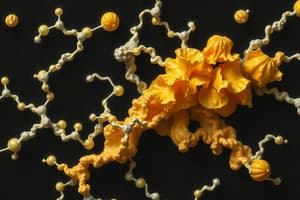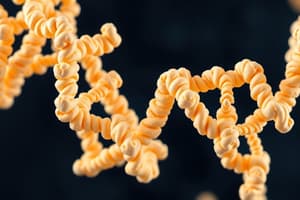Podcast
Questions and Answers
Which element is present in protein but not in carbohydrates, fats, or alcohol?
Which element is present in protein but not in carbohydrates, fats, or alcohol?
- Oxygen
- Carbon
- Hydrogen
- Nitrogen (correct)
The body cannot produce nonessential amino acids, so they must be obtained through diet.
The body cannot produce nonessential amino acids, so they must be obtained through diet.
False (B)
Besides animal sources, name two plant-based foods that provide 'complete' protein.
Besides animal sources, name two plant-based foods that provide 'complete' protein.
Soy and Quinoa
For the average adult, the recommended protein intake is 0.8 grams per ______ of body weight.
For the average adult, the recommended protein intake is 0.8 grams per ______ of body weight.
Match the following scenarios with the appropriate protein requirement adjustments:
Match the following scenarios with the appropriate protein requirement adjustments:
What is the first step to calculate a client's protein needs if their weight is given in pounds?
What is the first step to calculate a client's protein needs if their weight is given in pounds?
Under which circumstance is the body most likely to use protein for energy?
Under which circumstance is the body most likely to use protein for energy?
Protein supplements are strictly regulated as food and drugs to ensure their safety and nutrient content.
Protein supplements are strictly regulated as food and drugs to ensure their safety and nutrient content.
Flashcards
Elements in protein
Elements in protein
Protein contains carbon, hydrogen, oxygen, and nitrogen, unlike carbohydrates and fats.
Functions of protein
Functions of protein
Proteins build and repair tissues, produce hormones and enzymes, and regulate bodily functions.
Building blocks of proteins
Building blocks of proteins
Amino acids are the basic units that combine to form proteins.
Essential vs Nonessential amino acids
Essential vs Nonessential amino acids
Signup and view all the flashcards
Protein calorie content
Protein calorie content
Signup and view all the flashcards
Protein digestibility
Protein digestibility
Signup and view all the flashcards
Protein recommendations
Protein recommendations
Signup and view all the flashcards
Protein supplements
Protein supplements
Signup and view all the flashcards
Study Notes
Protein Structure and Function
- Protein is a crucial macronutrient, found in every cell.
- It's involved in building and repairing tissues, producing hormones, enzymes, and antibodies.
- It also plays roles in regulating blood pressure and fluid balance.
- Protein contains carbon, hydrogen, oxygen, and nitrogen.
- The fundamental units of proteins are amino acids.
- Amino acids are continually broken down and reconfigured into diverse proteins.
- Some amino acids are essential (obtained from diet), while others are nonessential (synthesized by the body).
Protein Energy Value
- Protein provides 4 calories per gram.
- Protein usage for energy is inefficient, as nitrogen removal needs an expenditure.
- Protein is only utilized for energy when carbohydrate and fat intake is insufficient.
Protein Sources and Digestibility
- Animal protein digestion is near 100%.
- Plant sources like soy and quinoa are also complete protein sources.
- Combining various plant-based protein sources, like grains and vegetables, can fulfill protein needs.
- Vegetarian and vegan diets can be perfectly healthy, as demonstrated by some populations.
Protein Recommendations for Adults
- The recommended daily allowance (RDA) for an average adult is 0.8 grams of protein per kilogram of body weight.
- This is equivalent to 45–60 grams per day, on average.
Protein Needs in Specific Populations
- Protein needs are higher during growth (infants, children, pregnant women).
- Elevated protein needs are also seen during healing (burns, surgery, malnutrition).
- Higher activity levels may increase calorie and protein requirements.
Protein Supplements
- Protein supplements are common among athletes and bodybuilders,
- Protein powders usually contain no additional nutrients,
- These supplements lack regulation in the same way as conventional food or pharmaceuticals, despite being aggressively marketed.
Calculating Protein Needs
- To calculate protein needs in grams, divide weight in pounds by 2.2 to get weight in kg, then multiply this by 0.8.
- Nitrogen balance is a clinical indicator of protein status.
Studying That Suits You
Use AI to generate personalized quizzes and flashcards to suit your learning preferences.




